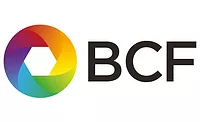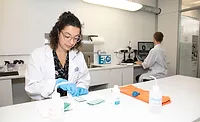Anti-Viral Surface Coating to Prevent the Spread of COVID-19 Through Touch


As declared by the World Health Organization (WHO), presently the whole world is facing a pandemic and a global crisis caused by a novel virus that was discovered to be the cause of a large and rapidly spreading outbreak of respiratory disease, including potentially fatal pneumonia, in Wuhan, China (starting January 9, 2020). The virus was provisionally designated 2019-nCoV and later given the official name SARS-CoV-2. The disease caused by the virus was officially named Coronavirus Disease 2019 (Covid-19) by WHO.
The SARS-CoV-2 is an enveloped, positive sense, single-stranded
SARS-CoV-2 is a delicate but highly contagious virus capable of spreading primarily from person to person. It also spreads when a person touches a surface that an infected person has coughed or sneezed on, and then touches their nose, mouth or eyes. On the personal level hygiene measures are recommended to prevent the spread of disease, especially in institutions where individuals are in contact with patients or contaminated fomites. Washing hands with soap and water or with alcohol-based hand rubs is effective for interrupting virus transmission.
Although viruses don’t grow on any non-living surfaces, recent studies show Corona viruses can remain viable or infectious on metal, glass, wood, fabrics and plastic surfaces for several hours to days, irrespective of the surface looking dirty or clean. Yet the Corona viruses are relatively easy to destroy using simple disinfectants like ethanol (62-71%), hydrogen peroxide (0.5%) or sodium hypochlorite (0.1%)2 by breaking the delicate envelope that surrounds the tiny microbe. However, it’s practically impossible to sanitize a surfaces all the time, and cleaning a surface doesn’t guarantee that it won’t get contaminated again. It’s a much wiser solution in such a scenario if the surface can repel the pathogens, making it non-stick and/or ‘sanitize by itself’ by neutralizing the contaminated pathogens quickly. Studies show that the spike glycoprotein of COVID-19 allows the virus to dock and bind to the ACE2 surface proteins of human epithelial cells in the respiratory track, thereby infecting these cells. Association of the COVID-19 spike glycoprotein with host ACE2 surface protein is a crucial step for infection.
Our research aim is to create a surface coating with a relatively low surface energy value that can repel the spike glycoprotein, and also through the use of active chemicals, inactivate the spike glycoprotein as well as viral nucleotides. As we have already developed an anti-microbial coating solution virtually for all surfaces with an effective combination of nano-actives that has proven literature support as an anti-virus too, we are pretty convinced about its performance as an anti-viral too. This technology should fight the transmission of virus from non-living articles to living body cells by touch.
Literature shows that the nanoparticles (NPs) of various metals and metal oxides like zinc oxide nanoparticles (ZnONPs)3, cuprous oxide nanoparticles (CuONPs)4, silver nanoparticles (AgNPs)5,6, nano-sized copper (I) iodide particles (CuINPs)7, gold nanoparticles on silica nanoparticles (Au-SiO2NPs)8, and also some quaternary ammonium cations commonly called QUATs9 are very promising to inactivate viruses and are well proven.
The product we have developed, NANOVA HYGIENE+ as an anti-microbial coating for surfaces like fabrics, plastics, metals and concretes contains the cocktail of non-migratory QUATs and positively charged AgNPs as bioactive nanoparticles dispersed into binder polymers. This anti-microbial coating also shows an extremely low surface energy value (>20 mN/m)10 and behaves as an omniphobic surface by repelling water and oil together. Contact angels were >130o and >50o when measured against water and hexadecane as probes10, respectively. This coating has proven test reports11 on protection against bacteria pathogens up to 99.9% as per the global standard JIS Z2801. The coated surfaces also have shown to work effectively against fungi12 and algae pathogens.
From available published data in literature, we can safely opine that NANOVA HYGIENE+ would be a potential coating candidate to repel and inactivate the virus on surfaces, hence could be a potential material to address the present problem of COVID-19 spread through surface touch (Figure 2).
The plausible ways of functioning of the doped nano-active materials against COVID-19 viruses would be as follow:
- As AgNPs have been reported to inhibit the replication of virus nucleotides, the main mechanism of its being virulent. It binds to electron donor groups such as sulfur, oxygen, and nitrogen commonly found in enzymes within the microbe. This causes the enzymes to be denatured, thus effectively incapacitating the energy source of the cell and causing the microbe to quickly die
- The cationic silver (Ag+) or QUATs might work to inactivate the SARS-CoV-2 by interacting with its surface (spike) protein S based on its charge, like it works in HIV, Hepatitis viruses, etc.5,6.
As NANOVA HYGIENE+ omniphobic antimicrobial coating shows complete disablement of various pathogenic bacteria already and further on the basis of available scientific supports, we are of the opinion that the present formula should work against a broad spectrum of viruses as well. Initial anti-viral tests of the coating have been performed using MS2 Bacteriophage (Poliovirus), small non-enveloped RNA virus of the family Leviviridae. The results show an anti-viral efficacy13 of 99.9% in just 2 hours of contact with the surface, as per global standard AATCC 100-2012. Further, an anti-viral test is in process to establish its efficacy on the inactivation of COVID-19 on different surfaces to stop the secondary spread from various surfaces to living cells through touch. Once validated, it has numerous applications virtually for all surfaces like fabric (mask, gloves, doctor coats, curtains, bed sheet), metal (lifts, doors handle, nobs, railings, public transport), wood (furniture, floors and partition panels), concrete (hospitals, clinics and isolation wards), and plastics (switches, kitchen and home appliances), and potentially could save many lives.
Acknowledgments
I would like to thank Dr. Santanu Dasgupta, Dr. Chitranshu Kumar and Dr. Manish R. Shukla of Reliance Industries Limited for their help in facilitating validation studies to test efficacy against different viruses and for their technical inputs in preparing this document.
References:
- Chen, Y., Liu, Q., Guo, D. Emerging Coronaviruses: Genome structure, replication, andpathogenesis. J Med Virol, 2020.
- Kampf, G., Todt, D., Pfaender, S., Steinmann, E. Persistence of Coronaviruses on inanimatesurfaces and its inactivation with biocidal agents. J Hosp Infect, 2020.
- Tavakoli A, Ataei-Pirkooh A, Mm Sadeghi G, Bokharaei-Salim F, Sahrapour P, Kiani SJ, Polyethylene glycol-coated zinc oxide nanoparticle: an efficient nanoweapon to fight against herpes simplex virus type 1, Nanomedicine, 2018;13(21), 2675–90.
- Hang, X., Peng, H., Song, H., Qi. Z., Miao, X., Xu, W., Antiviral activity of cuprous oxide nanoparticles against Hepatitis C Virus in vitro, J Virol Methods. 2015, 222,150-157.
- Elechiguerra, J.L., Burt, J.L., Morones, J.R., Camacho-Bragado, A., Gao, X., Lara, H.H., Yacaman, M.J., Interaction of silver nanoparticles with HIV-1.J Nanobiotechnology. 2005, 3(6), 6.
- Galdiero, S., Falanga, A., Vitiello, M., Cantisani, M., Marra, V., Galdiero, M., Silver nanoparticles as potential antiviral agents, Molecules. 2011, 16(10), 8894-918.
- Fujimori, Y., Sato, T., Hayata, T., Nagao, T., Nakayama, M., Nakayama T., Sugamata, R., Kazuo Suzuki, K., Novel Antiviral Characteristics of Nanosized Copper(I) Iodide Particles Showing Inactivation Activity against 2009 Pandemic H1N1 Influenza Virus, Applied and Environmental Microbiology, 2011, 951–955.
- Lysenko, V., Lozovski, V., Lokshyn, M., Gomeniuk, Y., Dorovskih, A., Rusinchuk, N., Pankivska, Y., Povnitsa, O., Zagorodnya, S., Tertykh, V., Nanoparticles as antiviral agents against adenoviruses, Advances in Natural Sciences: Nanoscience and Nanotechnology, 2018, 9, 025021.
- Torkelson, A., da Silva A.K., Love1, D.C., Kim, J.Y., Alper, J.P., Coox, B.,1, Dahm, J., Kozodoy, P., Maboudian, R., Nelson, K.L., Investigation of quaternary ammonium silane-coated sand filter for the removal of bacteria and viruses from drinking water, J. Applied Microbiology, 2012, 113, 1196-1207.
- Nova Surface Care Centre, Report No: NSCC/SER/06 Dated: 24/08/2019.
- Biotech Testing Services, Certificate No: 1900577/3 Dated: 26/06/2019.
- The Bombay Textile Research Association, Certificate No: BTL/TR/1700912/MWO/3/2017 Dated: 27/06/2017.
- Biotech Testing Services, Certificate No: 2000995/2 Dated: 18/04/2020.
For more information, email swapan.ghosh@nsccindia.com.
Looking for a reprint of this article?
From high-res PDFs to custom plaques, order your copy today!








